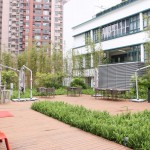The term privately owned public space may sound like an oxymoron. It refers to areas within private properties that are legally required to be open for use by the public. In Hong Kong, the policy of creating public open space in private developments (POSPDs) was introduced in 1980, with the aim of optimising land use for better urban development. According to the Lands Department and Buildings Department, there were a total of 56 POSPDs in Hong Kong as of June 2014.
Since the Times Square controversy, the government began to re-examine the provisions of POSPDs and to collect information about the sites across the city. In 2011, the Development Bureau issued the Public Open Space in Private Developments Design and Management Guidelines in response to this issue. The guidelines provide suggestions on the design, facilities and greening areas of POSPDs. But they are not legally-binding which may limit their effectiveness in managing POSPDs.
For instance, some POSPDs are hard to access, poorly-maintained and have opening hours shorter than the 13-hour requirement laid out in the guidelines. According to a survey conducted by the Audit Commission in October last year, some POSPDs have extremely low patronage rates because of irregularities such as locked gates, closure of passenger lifts and obstructed access. The survey highlighted one case in which visitors were required to climb 200 steps to reach the open space.
Central and Western district councillor Ted Hui Chi-fung agrees that due to bad design or poor maintenance, some POSPDs fail to attract members of the public to enjoy them. PMQ, the former Police Married Quarters in Central, is one example.

The PMQ revitalisation project, which started in 2010, transformed the two previous police residential blocks, built in 1951, into a creative art hub. The government said there should be three main objectives in the layout for the PMQ development, one of which was “provision of local open space”. When it consulted the Central and Western District Council on its plans, the developer stated there would be three open space areas in the new PMQ. However, Hui says the locations and usage of the open space areas were not stated clearly in the proposal.
When PMQ officially opened in June last year, Hui was disappointed to find that the three open space areas were not user-friendly at all. They include the lower entrance of PMQ where people can sit on benches and watch visitors coming in; a small space located at the back of the building’s courtyard where people can sit and relax, and the fourth floor Plateau which serves as a footbridge to connect the two blocks of the building.
Hui thinks the three open spaces are far from satisfactory as they are either too small for people to organise activities in them or are unnoticed by most visitors due to their inconspicuous locations. “When the developer [of PMQ] showed us the number of open spaces, we thought it would be enough but they ended up in some unnoticeable areas or corners. I think it’s a bit unacceptable,” he says.






































